Tag: Agriculture for Impact

14 Ways Agriculture is Reducing Poverty
Global: To to warm up for the World Food Prize giving in Iowa next month, we examine how our supporters are using agriculture as a means to empower the poorest.
Read MoreNew Sustainable Intensification Database Launches
Global: Agriculture for Impact compiles evidence-based overview and case studies of key approaches to tackling food insecurity in Africa.
Read MoreWhat Role for Smallholders in Agribusiness Development?
Global: Farming First reports on roundtable discussions exploring the potential roles and opportunities for smallholder farmers in future agribusiness development hosted by the UK Parliament.
Read MoreSir Gordon Conway: Supporting the Soil that Supports African People
Africa & Middle East: Montpellier Panel Chair Sir Gordon Conway explains why the latest report champions soil health for food security.
Read More“When I Grow Up… I Want To Be A Plant Scientist”
Africa & Middle East: Encouraging more young Africans to study the agricultural sciences could be a route to a food secure and prosperous continent.
Read MoreUsing Education to Create a Generation of “Agripreneurs”
Africa & Middle East: How to overcome the many barriers and pitfalls to becoming an agricultural entrepreneur in Africa.
Read MoreEmily Alpert: Can You Be Resilient on One Acre or Less?
Africa & Middle East: Our guest author, Emily Alpert, Deputy Director of Agriculture for Impact, concludes our series of blog articles on resilience published in partnership with the International Food Policy Research Institute (IFPRI) ahead of the conference “Building Resilience for Food and Nutrition Security” 15-17 May 2014. An acre is about the size of a football pitch. That might seem like a […]
Read More






